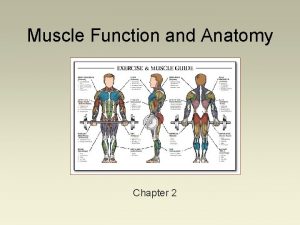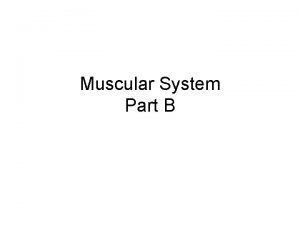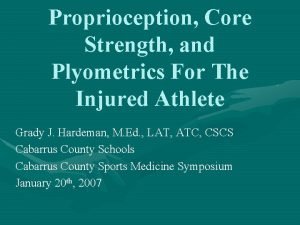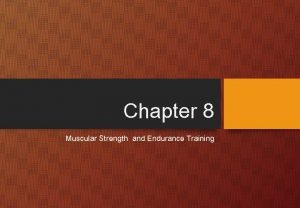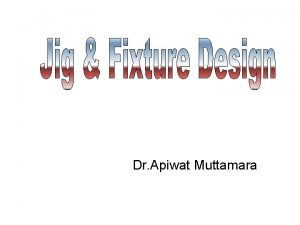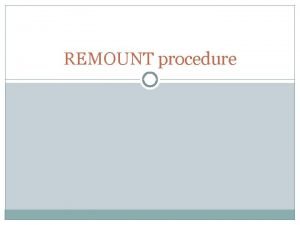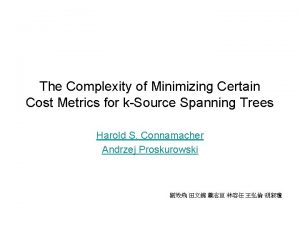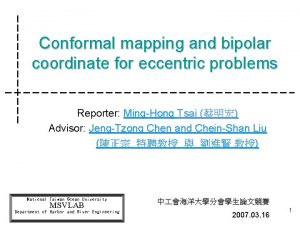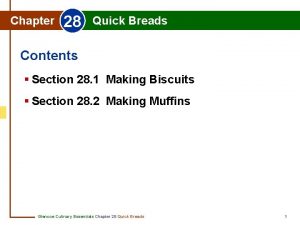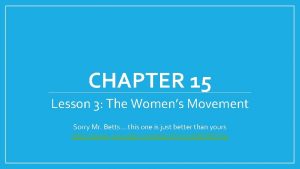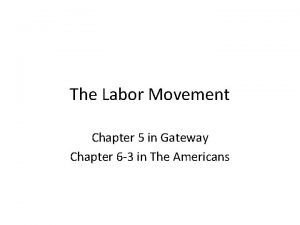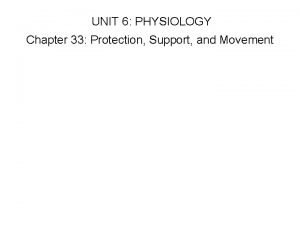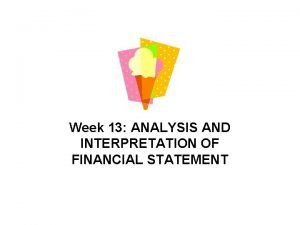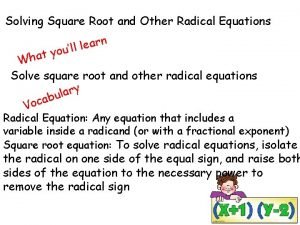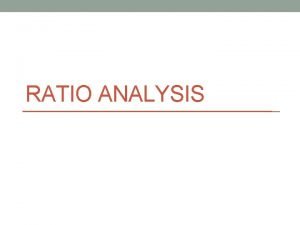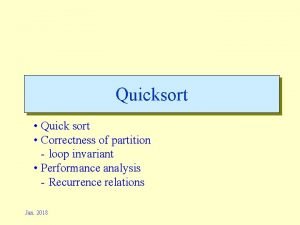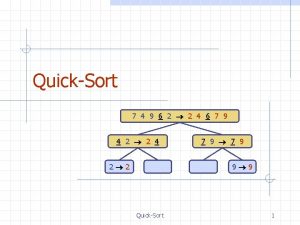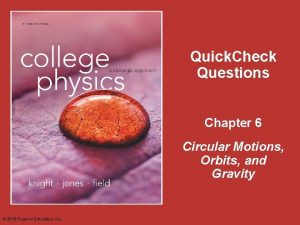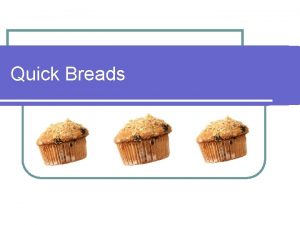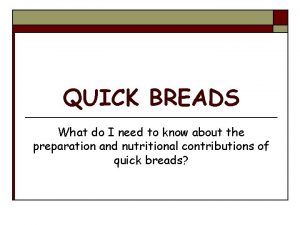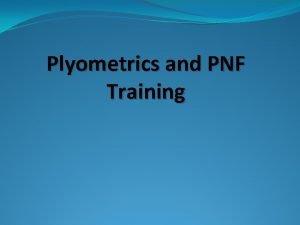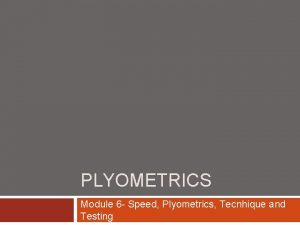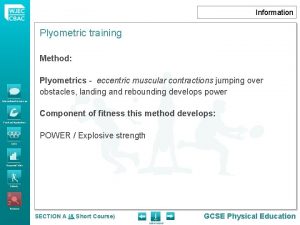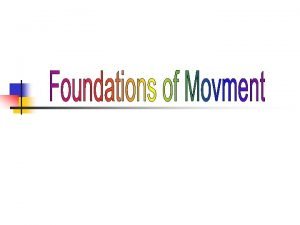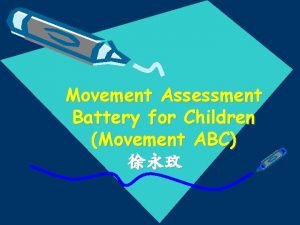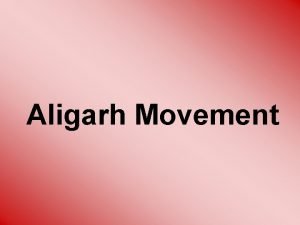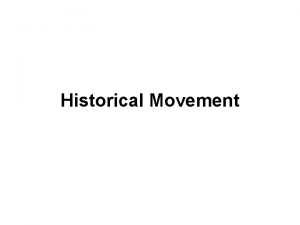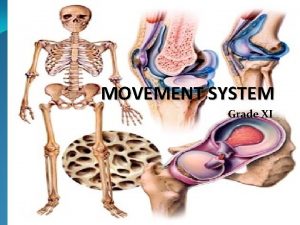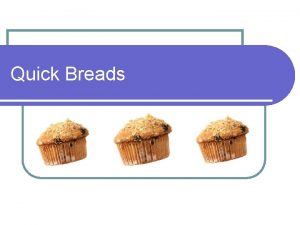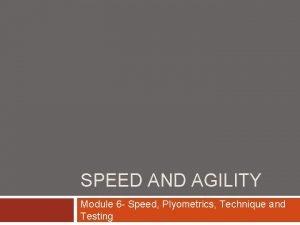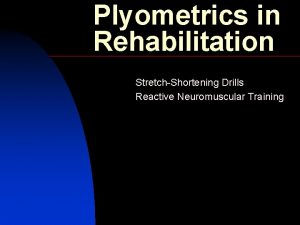chapter 9 Plyometrics Plyometrics Quick movement of eccentric






















































- Slides: 54

chapter 9 Plyometrics

Plyometrics • = Quick movement of eccentric activity rapidly followed by a burst of concentric activity to produce a powerful movement • Purpose: increase power of movements Plio = more Metric = measure

Figure 9. 1

Mechanical Components • Muscle lengthening increases elastic tension of noncontractile tissue stored elastic (potential) energy. • If immediately followed by a rapid concentric contraction, release of elastic energy contributes to total muscle output.

Neurological Components • Muscle stretch (eccentric lengthening) stimulates the muscle spindle to create a reflex shortening (concentric). • Movement must occur rapidly for the stretch reflex to occur.

Influential Factors • • Strength Flexibility Speed of movement Efficiency of movement (coordination)

Plyometric Phases: Stretch-Shortening Cycle 1. Eccentric phase – – – Muscle lengthens to take up slack and stretch elastic components. “Sets” the muscle. Stores potential energy as elastic energy. Muscle spindle responds to a rapid stretch and accommodates to a slow stretch. Best with rapid eccentric movement in a partial range of motion. (continued)

Plyometric Phases: Stretch. Shortening Cycle (continued) 2. Amortization phase – – – Must immediately follow the eccentric phase = Time it takes to transfer from eccentric to concentric motion Too much time: potential energy absorbed and dispersed, and spindle reflex overridden by cognitive functions (continued)

Plyometric Phases: Stretch. Shortening Cycle (continued) 3. Concentric phase – Stretch reflex causes increased muscle activity. – Stored (potential) energy is released to increase output. – The combined result is greater muscle performance.

Pre-Plyometric Considerations • Plyometrics is used in therex near the end of the program. • Used with patients returning to power-based sports: basketball, volleyball, gymnastics, track and field, softball, baseball, skating, swimming, soccer, football • Serve as a bridge between therex and sportspecific activities

Plyometric Program Design Mode of training: based on body part Lower-body plyometrics – – – Jumps in place Standing jumps Multiple hops and jumps Bounds Box drills Depth jumps (continued)

Plyometric Program Design (continued) Upper-body plyometrics – Medicine-ball throws – Medicine-ball catches – Push-ups Trunk plyometrics – Medicine-ball sit-ups – Plyometric sit-ups (continued)

Plyometric Program Design (continued) • Intensity: stress of the activity • Volume: – Lower extremity: number of foot contacts – Upper extremity: reps and sets or number of throws – Beginner: 80 -100/session – Intermediate: 100 -120/session – Advanced: 120 -140/session • Recovery: between reps = 5 -10 s; between sets = 2 -3 min • Frequency: once a week to three times a week (QW – TIW)

Program Considerations • • Age: <16 years Weight: >220 pounds Competitive level Surface: not too hard, not too soft Footwear: stable yet absorbing Progression: allow for overload adaptations Goals based on individual needs

Precautions • • Time: early in the session Delayed-onset muscle soreness Proper supervision Depth jumps – Max = 48 in. – Range = 16 to 42 in. – Norm = 30 to 32 in. (if >220 lb, range = 20 to 30 in. ) • Contraindications – Acute inflammation – Post-op – Instability

Exercise Progression • Beginning stages – Double-leg takeoffs – Increasing difficulty levels dependent on athletic level, learning aptitude • With increased mastery, amplitude increases • Consistent emphasis – Coordination – Correct movement and motor patterns

Exercise Techniques • Landing exercises – To teach proper foot strike – Use of ankle, knee, and hip to absorb shock – Correct body alignment • Stabilization jumps – To reinforce correct landing technique – Raise levels of eccentric and stabilization strength – Same as landing exercises, but landing position is held 5 s before next jump (continued)

Exercise Techniques (continued) • Jumping up – To teach takeoff action and arm use – For jump on box: Emphasize arm swing, Jump up with leg tuck • In-place bouncing movements – For quick reaction off ground and vertical displacement – Tuck jump, scissors jump, increasing vertical jump (continued)

Exercise Techniques (continued) • Short jumps – To teach horizontal displacement of center of gravity – Two-foot takeoffs multiple-step takeoffs, power skipping • Long jumps – To add more horizontal velocity – Leg bounding, bounding hops

Exercise Techniques (continued) • Shock jumps – To raise explosive power to highest levels – Impose high neural demand – Advanced form of training—require a large training base – Jump boxes, rebound hurdles

Equipment • Boxes: 16 in. to 48 in. (non-slip surfaces on floor, boxes) • Cones • Hurdles • Medicine balls • Other equipment

Precautions • Increase one factor q 3 d, especially in early phases. • Provide constructive cues to correct performance. • Avoid pain and swelling. • Understand tissue integrity: Be alert to progression tolerance. • Understand patient’s confidence level.

Figure 9. 4

Figure 9. 6 a 1

Figure 9. 6 a 2

Figure 9. 6 b 1

Figure 9. 6 b 2

Figure 9. 6 b 3

Figure 9. 7 a 1

Figure 9. 7 a 2

Figure 9. 7 b 1

Figure 9. 7 b 2

Figure 9. 7 c 1

Figure 9. 7 c 2

Figure 9. 8 a 1

Figure 9. 8 a 2

Figure 9. 8 a 3

Figure 9. 8 b 1

Figure 9. 8 b 2

Figure 9. 8 b 3

Figure 9. 9 a 1

Figure 9. 9 a 2

Figure 9. 9 b 1

Figure 9. 9 b 2

Figure 9. 9 b 3

Figure 9. 10 a 1

Figure 9. 10 a 2

Figure 9. 10 b

Figure 9. 11 a 1

Figure 9. 11 a 2

Figure 9. 11 b 1

Figure 9. 11 b 2

Figure 9. 13 a

Figure 9. 13 b
 Eccentric movement
Eccentric movement Cardiac muscle tissue labeled
Cardiac muscle tissue labeled Quick find vs quick union
Quick find vs quick union Quickchek menu
Quickchek menu Core plyometrics
Core plyometrics Plyometrics involves moving a weight as rapidly as possible
Plyometrics involves moving a weight as rapidly as possible Plyometrics disadvantages
Plyometrics disadvantages Lateral barrier jumps
Lateral barrier jumps Needle house method
Needle house method Eosinophil histology
Eosinophil histology Ls&s low vision
Ls&s low vision 321 principle
321 principle Eccentric nucleus histology
Eccentric nucleus histology Laboratory remounting
Laboratory remounting Balancing occlusion
Balancing occlusion Sicipath
Sicipath Lathe machine mcq
Lathe machine mcq Eccentric motivation
Eccentric motivation Movement and non-movement area
Movement and non-movement area Sometimes, these movements are called axial movements
Sometimes, these movements are called axial movements Section 28-1 yeast dough basics
Section 28-1 yeast dough basics Concept mapping chapter 10 meiosis 1 and meiosis 2
Concept mapping chapter 10 meiosis 1 and meiosis 2 Chapter 15 lesson 3 the women's movement
Chapter 15 lesson 3 the women's movement Farmers and the populist movement section 3
Farmers and the populist movement section 3 Scab
Scab Farmers and the populist movement section 3
Farmers and the populist movement section 3 Chapter 33: protection, support, and movement answers
Chapter 33: protection, support, and movement answers How does this cartoon depict the plight of the farmers
How does this cartoon depict the plight of the farmers Qtp quiz
Qtp quiz Vdoe quick checks
Vdoe quick checks Quick assets
Quick assets Purchasepath uw
Purchasepath uw Vowel screener
Vowel screener Yrityksen velkaantumisaste
Yrityksen velkaantumisaste Sort popular
Sort popular Solving square roots and other radical equations
Solving square roots and other radical equations Acid test ratio and quick ratio
Acid test ratio and quick ratio Quick acid ratio
Quick acid ratio Quick tix
Quick tix Loop invariant of quick sort
Loop invariant of quick sort Is quick sort in place
Is quick sort in place Quick software solutions
Quick software solutions Quick serve maintenance
Quick serve maintenance Click aqu
Click aqu Quick heal company profile
Quick heal company profile Quick grammar review
Quick grammar review Fire safety writing prompts
Fire safety writing prompts A coin sits on a turntable
A coin sits on a turntable 10 year old sarah stands on a skateboard
10 year old sarah stands on a skateboard Force and work relationship quick check
Force and work relationship quick check Quick breads belong to what group in the food pyramid
Quick breads belong to what group in the food pyramid Quick breads examples
Quick breads examples What are the nutritional contributions of yeast breads?
What are the nutritional contributions of yeast breads? Drop batters
Drop batters Classification of quick bread
Classification of quick bread
